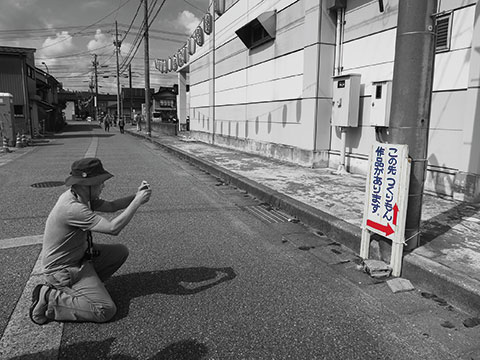ごあいさつ
木下直之 東京大学大学院教授 / 静岡県立美術館館長

わたしも美術館人、博物館人の端くれですから、この展覧会がいかに常軌を逸しているかということはよくわかります。普通はありえない。起こりえない。
展覧会とは、それをやろうと言い出す人がいなければ何も始まらない。いくら厚顔無恥とはいえ、それがわたしであるはずがない。すると、そんな奇特な人がいたということになる。しかし、賛同する人がいなければ話は前に進まない。さらにまた、実現に向かって動き回る人が欠かせない。そして、足をここにまで運んでくださった方々が展示を見ることで、はじめて展覧会は成立する。そのすべてのみなさんに感謝申し上げます。
さて、最初の難関は、木下直之の軌跡を見せるといっても、いったい何を見せればよいのかということでした。わたしが会場に座っているわけにはいかない。会期中に随時、「本人による加筆パフォーマンス」を行うつもりではありますが、わたしを見せても、それは老いた男のくたびれた姿であって、わたしの軌跡を見せたことにはなりません。
これまでに書いた12冊の本を「全集」に見立てることはすんなり決まりました。ヴァーチャルな「木下直之を全ぶ集める」展とリアルな「木下直之が全ぶ集まった」展の2本立て興行とすることは言葉遊びの先に決まった。こんなふうに、とめどもなく脱線というか、横滑りというか、問題が増殖してゆくことが「全集」を貫いている特徴だろうということにして、それならその一端をご覧いただこうということになった。会場の奥の方でも出てきますが、真面目にやろうとすると、ふざけたいというブレーキがすぐに働いてしまうのです。生まれつきですね。
「つくりもの」への関心だけはほぼ一貫していたので、まずはこの世界にみなさんをお連れしたいと思います。2017年の秋、これまでにたびたび訪れてきた福岡町つくりもんまつりをギャラリーエークワッドのスタッフと見に行ったところ、「この先つくりもん作品があります」看板に再会、野菜のつくりものを見るよりももっと感激しました。今から30年近く前、美術館学芸員として「作品」か「つくりもの」か、この先どちらを相手に生きて行こうかと悩んでいたころに出合った看板が、まだ使われていたのです。
当時も今も、「どっちなんだ」とついツッコミを入れたくなりますが、「どっちでもいいよ」と教えてくれるようなところがあります。わたしにとっては、境界線をめぐる旅の案内板です。
江戸に暮らす麦殿大明神(むぎどのだいみょうじん)を東京に招待したいという突然の思いつきにも、スタッフが辛抱強くつきあってくださいました。京浜急行金沢文庫駅前の金物屋の店先に姿を現すから迎えに行こう、ギャラリーに連れて帰ろうといったところで、何が何だかわからないですよね、普通は。
でも、「つくりものの世界」に馴染んでいきますと、麦殿大明神がだんだんと普通の人に見えてきますので、どうぞご安心ください。麦殿の目を通して、つくりものが次第に影をひそめ、はかないものの代わりに硬くて力強いものが姿を現し、近年では逆に柔らかいものが台頭してきた明治・大正・昭和・平成の日本の風景をご覧になってください。
Greetings
Kinoshita Naoyuki
Professor, The University of Tokyo/Director, Shizuoka Prefectural Museum of Art

It is easy for me to find how unusual this exhibition is since I am working in the world of museums. It is not unlikely or even possible to organize such an exhibition.
Before talking about the exhibition, I would like to thank all those who worked hard to realize this exhibition project. Nothing happens unless someone begins to plan. I am not the one, for sure, even if I am a little impudent. It means there was a laudable person who proposed it. But proposal alone is not enough. We need persons supporting the idea to realize the exhibition. There are people who are key drivers and implementors to make exhibition the reality. The last and the most important is the audience. An exhibition gets its life only when there are people visiting to see it and the staff to manage it behind.
The first challenge we faced in planning the exhibition was what to display to represent the journey of Naoyuki Kinoshita. It is not that I should be sitting in the exhibition hall. Though I plan to do “some performance during the exhibition to add some contents”, the exhibit of me in person surely does not represent my journey but a worn-out old man.
In the course of planning, agreement was reached without difficulty that we would display the 12 books I have written as collection of my works. The hidden wordplay led us to give exhibition dual nature: “Collecting (“atsumeru”) all of Naoyuki Kinoshita’s work” (virtual) and “The whole Naoyuki Kinoshita gets together (“atsumaru”) (real)”. This type of deviation or sidetracking may be the characteristics of my collection representing proliferative development of thoughts and ideas. And we may be able to show some of it here. You may find that I was born to be inclined to play about and that the more I try to behave serious, the more I become playful.
I, however, have something consistent throughout my life; interest in products. I visited Tsukurimon Festival (Festival of decoration) in Fukuoka town with the staff of Gallery A4. I have visited the festival many times. I was glad to find my familiar sign board there, saying “Tsukurimon works are displayed ahead”. The signboard gave much deeper impression than the vegetable decorations. It is the board that inspired me when I was at a loss about my future career. At that time, I was not sure if I would be a curator of a museum, specializing in fine arts or in products. I was surprised that the festival organizer still uses the same signboard. I would ask myself which I am specialized in now and was then. The signboard tells me it does not matter as long as I like the career. It is a signpost for my journey across the border.
I am appreciative of the gallery staff who have patiently worked with me to find the solution when I suddenly came up with the idea to invite Mugidono Daimyojin living in Edo to Tokyo. Ordinary people would be perplexed when I proposed them to go to Kanazawa Bunko station of Keihin Kyuko and take the god back to the gallery, saying he would be visiting a hardware shop there. Please feel relieved. When you are familiarized with the world of Tsukurimono products, Mugidono Daimyojin comes to look like an ordinary person. Through the eyes of Mugidono, you will see that artificial nature of Tsukurimono gradually disappears and fragility of products is replaced with essential solidity and strength. I hope you will enjoy the transition of Japanese townscapes of Meiji, Taisho, Showa and Heisei Era where there is another swing from hardness to softness in recent years.